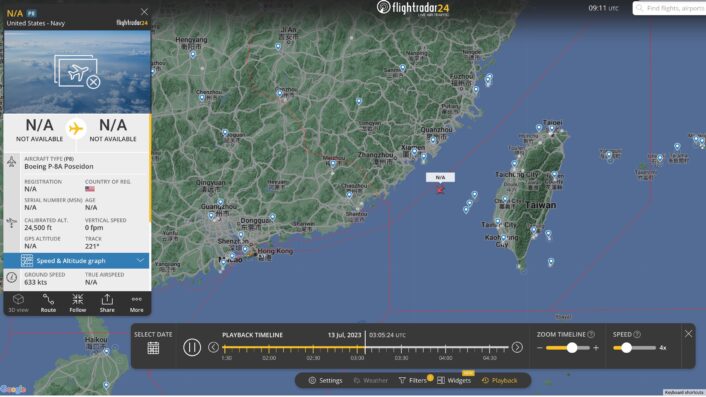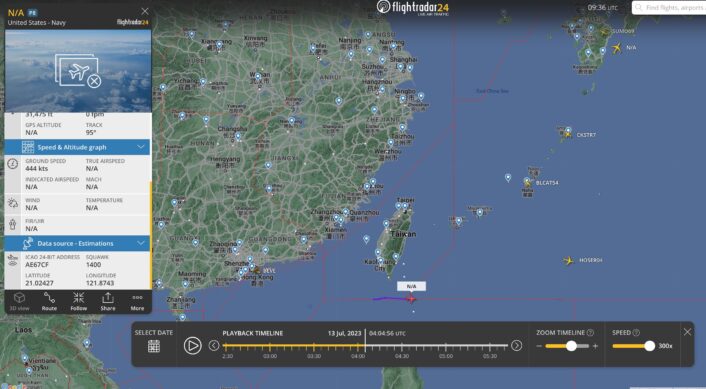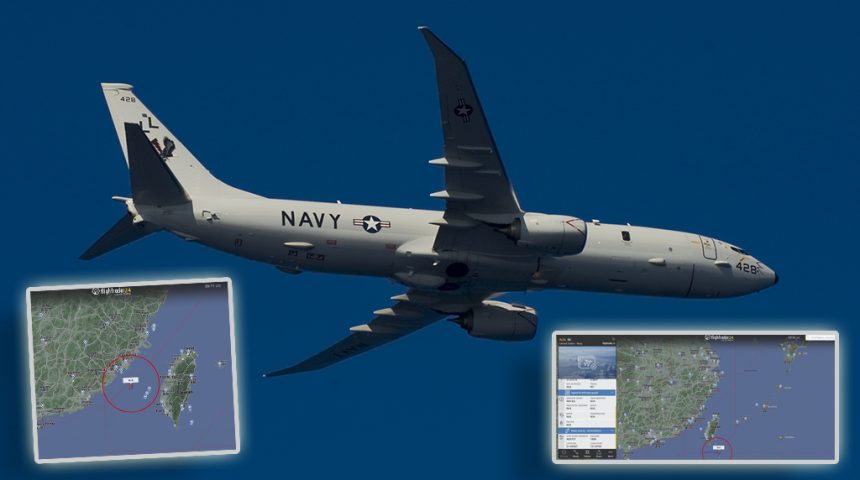China protested after a U.S. Navy P-8, tracking online, flew over Taiwan Strait.
On Jul. 13, 2023, at around 03.00AM UTC (11.00AM LT), a U.S. Navy P-8A Poseidon, flew through the Taiwan Strait, west of Taiwan island. The aircraft, with its Mode-S transponder turned on could be tracked online via MLAT on Flightradar24.com as if flew in international airspace, more or less along the border between the Taipei FIR (Flight Information Region) and Shangai FIR.
It’s worth remembering here that the FIR does not match with sovereign airspace: the FIR is the portion of aerospace within which an ATC agency has responsibility for providing air traffic services; whereas sovereign airspace is the one over the territorial sea out to twelve nautical miles from the coastline.
Taiwan has also an ADIZ (Air Defense Identification Zone), created by the United States Armed Forces after World War II, that covers most of Taiwan Strait, part of East China Sea and adjacent airspace. As per other ADIZs around the world, this ADIZ, is not defined in any international treaty and is not regulated by any international body: it is mostly over international airspace (territorial airspace begins only 12 miles from the coastline), hence, an intrusion into an ADIZ is not a violation of sovereign airspace. ADIZs extend well beyond a country’s territory, usually in the vicinity of contested areas, to give the country more time to respond to possibly hostile aircraft.
That being said, based on the flight tracking data shown on FR24, the P-8A Poseidon flew over the Taiwan Strait on a southwestern heading at 24,500 feet before turning east to egress the area (probably returning to Kadena AB, Japan), at 31,000 feet.


Although the U.S. P-8 routinely operate near Taiwan, the mission on Jul. 13 sparked official protest by Beijing. China’s Ministry of National Defense said the U.S. “hyped [the aircraft transit] publicly,” according to an English language statement citing a People’s Liberation Army Eastern Theater Command spokesperson, reported by USNI News.
“The troops of the PLA Eastern Theater Command have tracked and monitored the US aircraft in the whole course, and handled it in line with laws and regulations,” Col. Shi Yi said in a statement.
The 7th Fleet Command issued a public statement on the event:
A U.S. Navy P-8A Poseidon transited the Taiwan Strait in international airspace on July 13 (local time). By operating within the Taiwan Strait in accordance with international law, the United States upholds the navigational rights and freedoms of all nations. The aircraft’s transit of the Taiwan Strait demonstrates the United States’ commitment to a free and open Indo-Pacific. The United States military flies, sails and operates anywhere international law allows.
Dealing with the P-8A, these aircraft regularly fly ISR (Intelligence Surveillance Reconnaissance) missions across the world, including around Taiwan. As explained in a previous post: “These assets are much more than MPA (Maritime Patrol Aircraft): they are multi-mission platforms that can gather valuable intelligence using a wide array of sensors. Among these, an Advanced Airborne Sensor (a dual-sided AESA radar that can offer 360-degree scanning on targets on land or coastal areas, and which has potential applications as a jamming or even cyberwarfare platform according to Northrop Grumman); an APY-10 multi-mode synthetic aperture radar; an MX-20 electro-optical/infrared turret for shorter-range search; and an ALQ-240 Electronic Support Measure (ESM) suite, able to geo-locate and track enemy radar emitters. Moreover, all sensors contribute to a single fused tactical situation display, which is then shared over both military standard and internet protocol data links, allowing for seamless delivery of information amongst U.S. and coalition forces.”
The latest mission comes as Chinese combat aircraft are involved in drills around Taiwan with intrusions into the ADIZ as well as military activities around the island increased since former House Speaker Nancy Pelosi visited Taiwan last summer.









